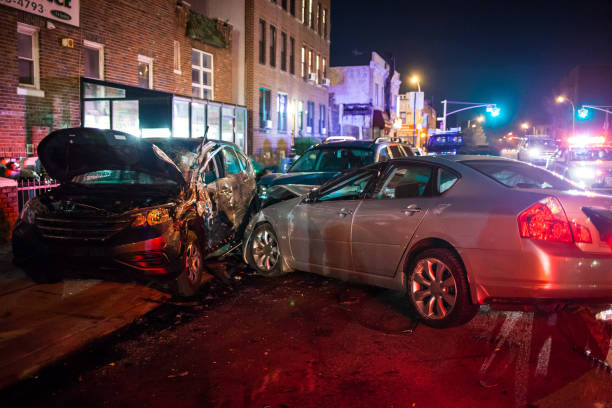
February 2, 2022 | Car Accidents
Introduction
We recently faced a very unique issue in connection with our client’s motor vehicle accident. In this case, the client was t-boned by a driver with a $100,000 policy. Our client ended up having a cervical fusion. Because of the accident, our client was out of work for a year, meaning he exhausted his personal injury protection (PIP) benefits and about $50,000 of his additional personal injury protection (APIP) benefits. We got the third party carrier to tender the $100,000 relatively quickly. However, our client’s no fault carrier had sent a notice of subrogation/lien rights to the third party carrier, saying that it was entitled to recover $50,000 out of the $100,000 proceeds. In short, the no fault carrier wanted to recover 100% of what it paid out as APIP benefits to the other driver, which meant that our client would then only be left with $50,000 to cover pain and suffering and future loss of medical bills and future lost earnings claims. The third party carrier asked us for help because it didn’t know what to do. We argued that the no fault carrier is not entitled to recover 100% if our client was not going to be made whole from the $100,000 settlement. The carrier ultimately agreed with our position. Our arguments to support this theory was as follows:
The Law
An insurance company which has paid APIP benefits for extended economic loss has a right of subrogation to recover the benefits paid from a third party tortfeasor. See Allstate v. Stein, 1 N.Y.3d 416 (2004); State Farm Ins. Co. v. Baltz Concrete Constr. Inc., 29 A.D.3d 777 (2nd Dept. 2006). This right is traditional, based in common law, and not pursuant to a statute. See Allstate v. Stein, 1 N.Y.3d 416 (2004) (noting that no statute refers to APIP benefits and that Insurance Regulation 11 NYCRR 65-1.3, which is the only reference of APIP benefits, “does not create a new right which did not exist at common law, but merely prescribes the form of a clause that declares [the carrier’s] pre-existing right”); Aetna Cas. & Sur. Co. v. Jackowe, 96 A.D.2d 37 (2nd Dept. 1983). It is equitable in nature. See Winkleman v. Excelsior Ins. Co., 85 N.Y.2d 577 (1995); see also State Farm Ins. Co. v. Baltz Concrete Constr. Inc., 29 A.D.3d 777 (2nd Dept. 2006) (stating that subrogation claim for “extended economic loss” pursuant to an “additional personal injury protection” endorsement is a “traditional equitable right of subrogation”).
The purpose of the subrogation rule is twofold: it provides a mechanism for the insurer to go after the party that caused the harm and it prohibits an insured from receiving a double recovery. See Winkleman v. Excelsior Ins. Co., 85 N.Y.2d 577 (1995). The insurance company as the holder of the right to subrogation acquires only the rights that its subrogor had, with no more enlargement or diminution. See Allstate v. Stein, 1 N.Y.3d 416 (2004); State Farm Ins. Co. v. Baltz Concrete Constr. Inc., 29 A.D.3d 777 (2nd Dept. 2006).
In the no fault context, by virtue of the right to subrogation, the insurance carrier is only entitled to that portion of a recovery that is allocable to the claim for extended economic loss. See Aetna Cas. & Sur. Co. v. Jackowe, 96 A.D.2d 37 (2nd Dept. 1983). The carrier does not have a right to subrogate for any claim for basic economic loss. This is because the insured is barred for suing for such claims under New York’s Insurance law. Insurance Law § 5104 (a) limits the items of damage that may be recovered in an action commenced by a person injured in a motor vehicle accident against another motor vehicle operator or owner, here the uninsured motorist, to noneconomic loss, i.e., pain and suffering (see Insurance Law § 5102 [c]), plus only that economic loss which exceeds basic economic loss, defined by statute as $50,000 for medical and hospital expenses, lost wages, and incidental expenses, with certain exceptions not applicable here. See Insurance Law § 5102 (a); see generally Matter of Adams (Government Empls. Ins. Co.), 52 A.D.2d 118, 120 (1976).
Thus, in the typical motor vehicle context, where there is a settlement from a third party, a hearing must be held to determine what portion of the recovery, if any, constitutes “additional personal injury protection” payments and what portion constitutes pain and suffering and any other non-subrogable claim made by plaintiff. Aetna Cas. & Sur. Co. v. Jackowe, 96 A.D.2d 37 (2nd Dept. 1983) (in personal injury action arising out of a motor vehicle accident, a hearing was ordered to ascertain “what portion of the settlement was intended to satisfy the basic and extended economic loss” of the claimants); Musgrave v. American Protection Ins. Co., 32 A.D.3d 916 (2nd Dept. 2006) (same); Dymond v. Dunn, 148 A.D.2d 56 (3rd Dept. 1989) (same). The Courts must carefully and cautiously apportion the award between the competing interests of both the carrier and the insured. See id. Insofar as the insured’s interests are concerned, it is routinely stated that “An insured who has sustained personal injury should not be required to pay for his no-fault benefits out of his recovery for pain and suffering. See Dymond v. Dunn, 148 A.D.2d 56 (3rd Dept. 1989); Celona v. Royal Globe Ins. Co., 85 A.D.2d 635 (2nd Dept 1981); Matter of Adams (Government Empls. Ins. Co.), 52 A.D.2d 118, 120 (1976).
Notably, not all payments from third parties encompass payments for APIP. For instance, a possibility exists that a jury may reject a claim for medical costs or lost wages and this must be taken into account when apportioning claims between the insured and the carrier in light of a subrogation action. See e.g., State Farm Ins. Co. v. Baltz Concrete Constr. Inc., 29 A.D.3d 777 (2nd Dept. 2006) (in personal injury action where plaintiff did not establish entitlement to loss of earnings and medical expenses, carrier was not entitled to recover benefits paid for extended economic loss pursuant to subrogation rights); Hyde v. North River Ins. Co., 112 Misc2d 855 (Rensselaer Co. Sup. Ct. 1982) (same).
In addition, New York applies the Common Fund Doctrine, but refers to it as the Substantial Benefit Rule. See Seinfeld v. Robinson, 246 A.D.2d 291 (1st Dept 1998). It is also referred to as the Reasonable Compensation Rule. See Richards v. United Health Services, 121 A.D.2d 68 (3rd Dept. 1986). The rule, no matter the name, is a simple one: it holds that where an insurer recovers a subrogation interest through the efforts of the insured’s attorney, it may be required to contribute toward the attorneys’ fee and costs of litigation. See id.; see also Breier v. Government Employees Ins. Co., 79 A.D.2d 967 (1st Dept. 1981).
Finally, New York has applied and adheres to the existence of the Made Whole Doctrine. See Winkleman v. Excelsior Ins. Co., 85 N.Y.2d 577 (1995); U.S. Fidelity & Gar. Co. v. Maggliore, 299 A.D.2d 341 (2nd Dept 2002). The rule, simply stated, holds that “an insurer has no right of subrogation against its insured when the insured’s actual loss exceeds the amount it has recovered from both the insurer and wrongdoer”. Winkleman v. Excelsior Ins. Co., 85 N.Y.2d 577 (1995). “The equitable principle underlying the made whole rule is that the burden of loss should rest on the party paid to assume the risk, and not on an inadequately compensated insured, who is the least able to shoulder the loss”. U.S. Fidelity & Gar. Co. v. Maggliore, 299 A.D.2d 341 (2nd Dept 2002). The Court of Appeals has applied this Made Whole Rule in the automobile liability context. See ELRAC v. Ward, 96 N.Y.2d 58 (2001).
The Law as Applied Here
Applying the above jurisprudence, we argued that the no fault carrier was not entitled to recoup any funds out of claimant’s $100,000 settlement with the third party driver.
Initially, in order to have a right to recover the full value of the claim, the no fault carrier must first show that half of the $100,000 of the settlement reasonably represents the benefits it paid claimant for extended economic loss. But such a showing seems unlikely given the overall value of claimant’s claims.
For instance, claimant underwent a cervical fusion. Courts have sustained pain and suffering awards for cervical fusions well in excess of $1,000,000. See Huff v. Rodriquez, 45 A.D.2d 1430 (4th Dept 2007) (sustaining $3.5 million award for past and future pain and suffering resulting from motor vehicle accident where plaintiff underwent spinal fusion surgery); Diaz v. W. 197th St. Realty Corp., 290 A.D.2d 310, 312, 736 N.Y.S.2d 361, 363 (2002) (in personal injury case with spinal fusion, court sustained award of $900,000 for past pain and suffering and $450,000 for future pain and suffering).
In addition, there still needs to be an accounting for a future loss of earnings claim, which easily surpasses $750,000 (at least $75,000 per year for the next ten years), and future medical costs, which, given the extent of his medical issues, will also be substantial.
Further, even if it can show that $50,000 of the $100,000 constituted APIP benefits, the no fault carrier still needs to compensate the insured for retaining and ultimately paying the plaintiff’s attorney for his actions in obtaining the settlement from the third party liability carrier. Here, claimant agreed to pay StolzenbergCortelli LLP a contingency of thirty three percent of any award.
Lastly, but perhaps most importantly, in light of claimant’s past extended economic loss, his future economic loss and his pain and suffering, both past and present, the award of $100,000 clearly fails to make him whole in terms of what he had prior to the subject motor vehicle accident. Since the settlement fails to make him whole, the no fault carrier loses any right to a subrogation claim regarding the settlement proceeds from the third party carrier.
Summary
While we acknowledge that a carrier is generally entitled to maintain a subrogation claim to recover payments made pursuant to an additional personal injury protection policy, under the specific and unique circumstances of this matter, the no fault carrier cannot exercise that right here. Simply stated, it will be too difficult for the no fault carrier to establish at a hearing what portion of the $100,000 settlement constituted additional personal injury protection benefits. This is especially true here where plaintiff’s economic loss and pain and suffering claims are tremendous. In any event, insofar as his personal injury claim is worth well in excess of $100,000, the settlement with the third party tortfeasor failed to make claimant whole, thereby extinguishing any subrogation claim the no fault carrier may have had.
StolzenbergCortelli LLP
 (914) 361-4888
(914) 361-4888

305 Old Tarrytown Rd.
White Plains, NY
10603
99 Main Street
Nyack, NY
10960
26 Court Street
Brooklyn, NY
11242
55 Old Turnpike Rd
#502
Nanuet, NY
10954